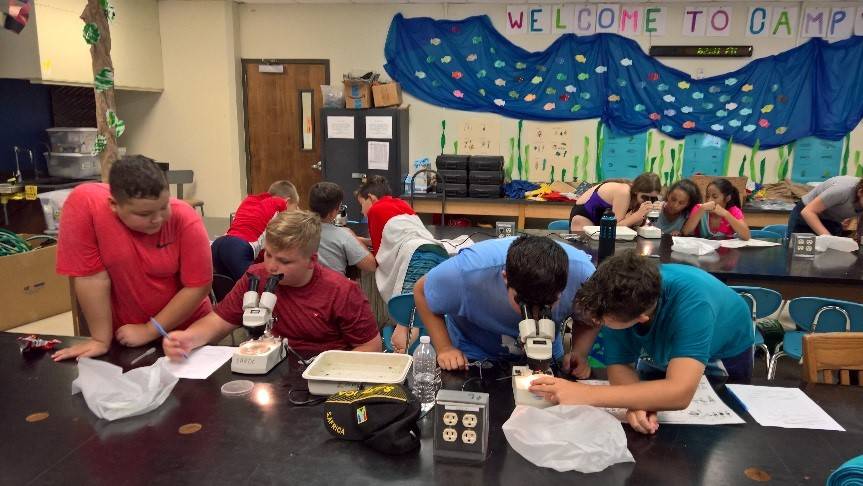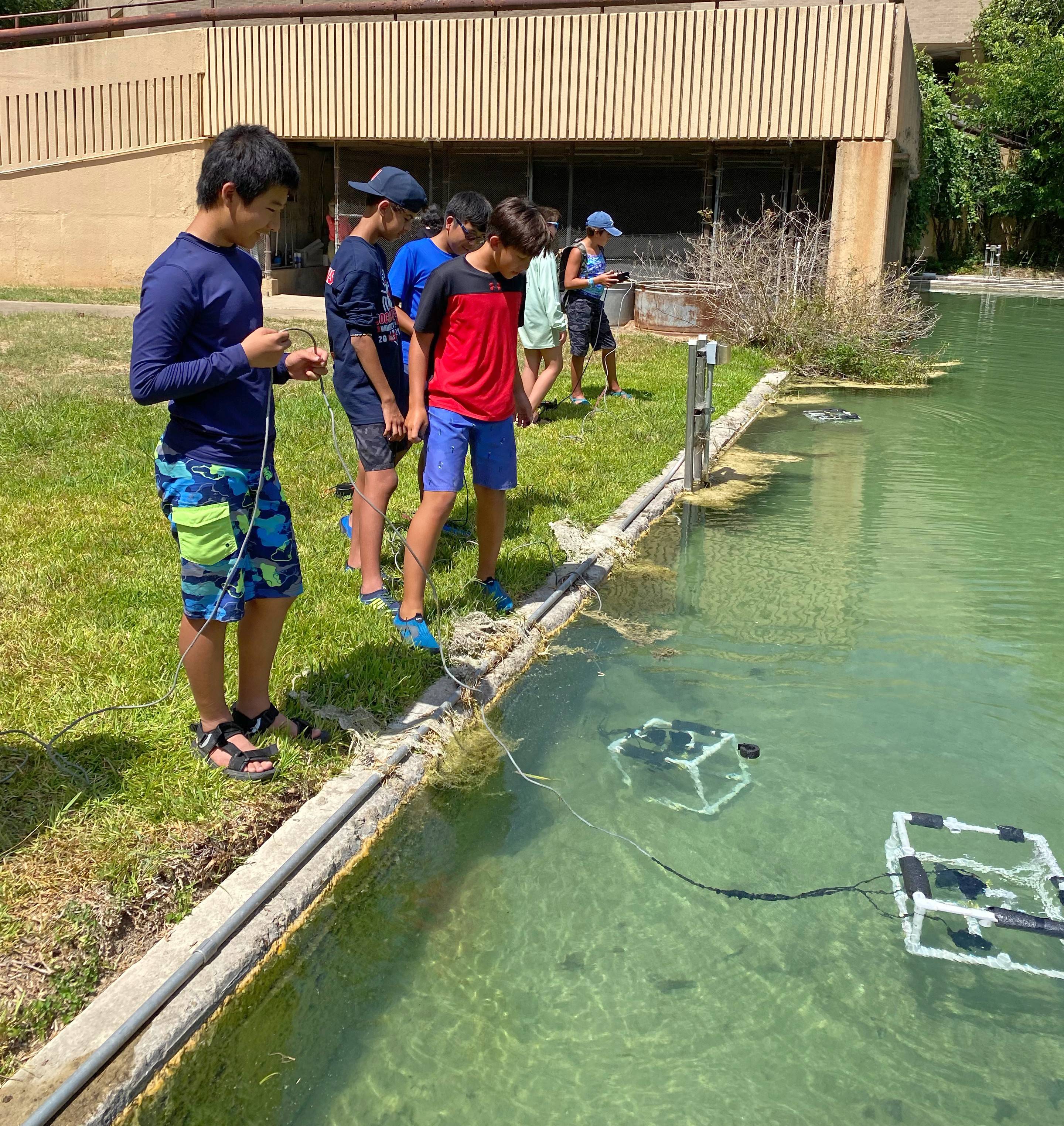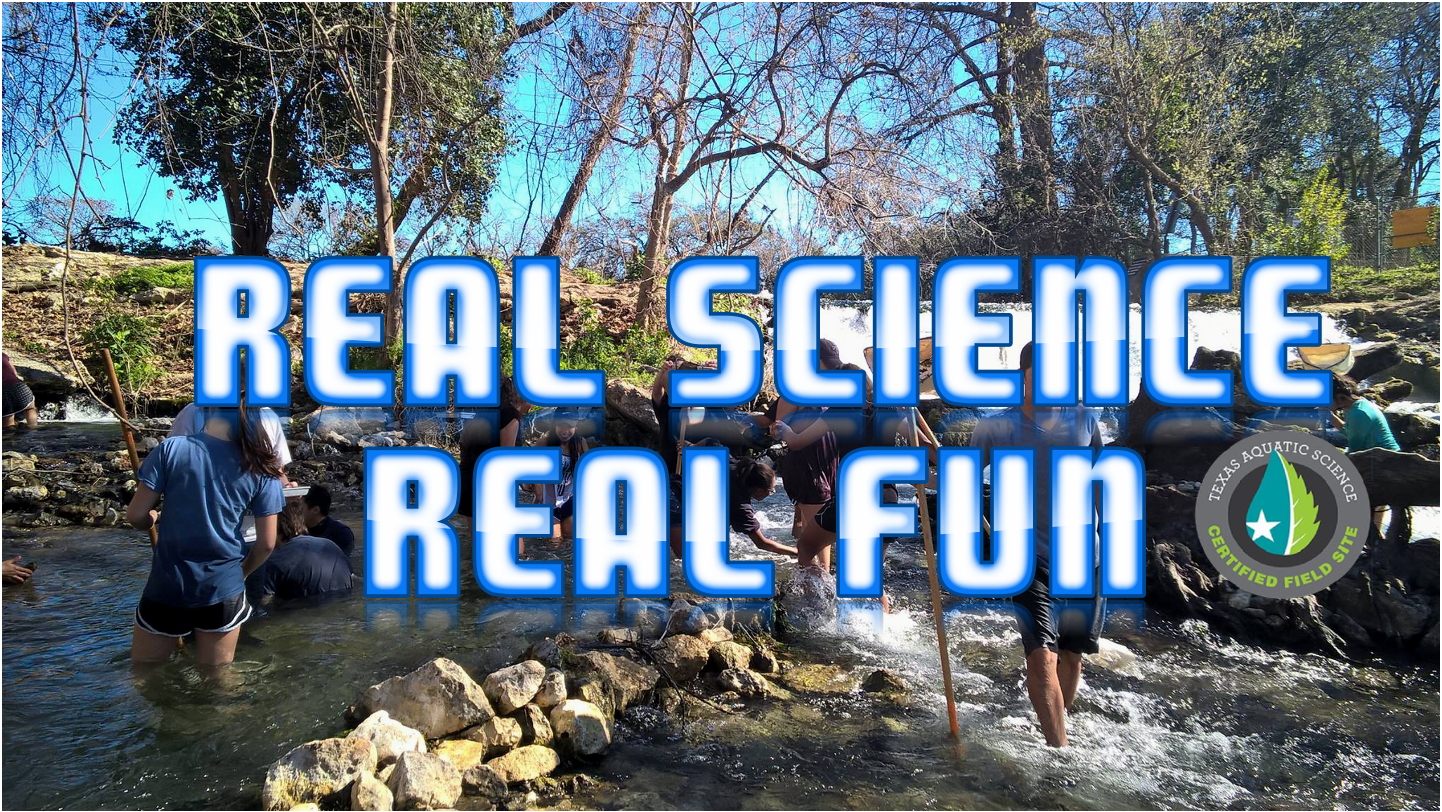Aquatic Studies Field Day
Field Day Activities

Aquatic Biology and Ecoloogy

Chemistry and Environmental Science

Remotely Operated Vehicles
Welcome to the Edwards Aquifer Research & Data Center (EARDC) located on the grounds of the stunning Texas State University campus. Come enjoy the day studying the biological, geological and hydrological wonders of a large limestone groundwater system, the Edwards Aquifer and the San Marcos River, both located in the beautiful Central Texas Hill Country. For More Information, Please Contact:
Kellie Donajkowski
Director for Education
Edwards Aquifer Research and Data Center
601 University Dr.
San Marcos, TX 78666
(512) 245-2329
FAX (512) 245-2669
E-Mail: eardc_education@txstate.edu
-
FIELD DAY PROGRAM INFORMATION
About the Field Days
Since 1979, the Edwards Aquifer Research and Data Center at Texas State University has invited schools and community groups to come and discover the amazing treasure of Central Texas's aquatic ecosystems. The Edwards Aquifer is a vast area of porous limestone rock that not only supplies drinking water to millions of Texans but is also home to an incredible array of creatures that are specially adapted to life deep below the earth. Students will be able to see these exceptionally rare and unique animals up close and will learn about their subterranean lifestyle. The Edwards Aquifer also feeds Sessom Springs and San Marcos river, both located on the Texas State campus. There are several field day options each focusing on a different area of study. All field days feature the option for a tour of the Meadows Center for Water and the Environment and a glass bottom boat ride in crystal clear Spring Lake and to see the diverse populations of fish, turtles, birds and aquatic plants that live there. Afterwards, groups may tour the free aquarium and educational displays at the Meadows Center for Water and the Environment.
Aquatic Biology and Ecology
Our most popular field day! Students will have a chance to explore the headwaters of the San Marcos river and/or Sessom Creek and collect and identify many diverse invertebrates that call these spring habitats home. Students will learn about water quality, aquatic ecosystems, insect life-cycles, and have the chance to use microscopes in a university lab environment. Recommended grades: 3 - 12.
Chemistry and Environmental Science
Students will conduct a hands-on investigation into the physical and chemical properties of a system of ponds, springs, streams, and an artesian well to discover more about the biological processes that keep our planet in balance. Students will learn about the chemical properties of water, oxygen and carbon cycles, acids and bases, and climate change. Recommended grades: 5-12
Remotely Operated Vehicles (ROV's)
This new class provides the opportunity for students to learn about the engineering design process and tackle problems independently. Students will work in small groups to design, create, and test their own underwater vehicles. They will be given all the parts they need to complete the engineering task where they will then drive their ROVs in our old fish hatchery ponds. Recommended grades: 5-12
-
SCHEDULE
Times are approximate, the following schedule can be altered to meet the specific needs of your group.
Reservations must be made in advance.
9:30 - Unload bus; welcome; change clothes (if needed); introduction to EARDC and the day’s activities.
10:15 – Begin activities
12:00 - Sack lunch on Texas State grounds
***You must provide your own lunch***
1:00 – Presentation on the geology, biology, and human significance of the Edwards Aquifer.
1:30 – Sampling and viewing of rare subterranean animals from the Artesian Well
***See live aquifer animal specimens caught in the net in the San Marcos Artesian Well, the most biodiverse groundwater site in North America***
2:00 - Leave for Meadows Center for Water and the Environment (optional, Meadows Center should be contacted separately)
***See three more threatened/endangered species - Fountain Darter (Etheostoma fonticola), Texas Blind Salamander (Eurycea rathbuni), and the San Marcos Salamander (Eurycea nana)***
2:30 - Glass-bottom boat tour of Spring Lake
***See San Marcos Springs, life in Spring Lake and an underwater archaeological excavation***
3:00 - Leave for home -
PRICE AND POLICIES
LOCATION: We are located in the Freeman Aquatic Biology Building on the main Texas State University Campus in San Marcos. Our physical address is 220 E Sessom Dr. San Marcos, TX. We are near the intersection of Aquarena Springs Dr. and Sessom Dr., right across from the Kerby Lane.
COST: $75.00/student group of 15 or fewer; $5.00 for each additional student. There is no charge for teachers and other adults accompanying the group. Minimum charge: $75.00; MAXIMUM GROUP SIZE: 40 students.
PAYMENT: Cash, Credit Cards or Checks are accepted. Checks are made payable to: Texas State University. Payment will be collected upon arrival.
*GLASS BOTTOM BOAT TOUR (optional): Cost is an additional $4.50 per student and $6.00 per adult - Payment will be collected upon arrival at Meadows Center. Please note that you will need to bring a separate check for the glass bottom boat tour!
*MEADOWS CENTER GUIDED TOUR (optional): For $7, students can take part in a guided tour of the Meadows Center for Water and the Environment. This includes a glass bottom boat tour, guided wetlands walk, aquarium and discovery hall tour, and educational games and activities. Tour lasts approximately 2 hours.* The Meadows Center will need to be contacted separately to book these tours.
TRANSPORTATION and PARKING: It is recommended that groups arrive by bus. If your group intends to arrive by private auto, we must be informed in advance so that special parking arrangements can be made.
Parking is $5 per car and $10 for non-school buses.REMEMBER!
This is a fun day and you will get wet! All participants should arrive in clothes that they plan to get wet in, but changing rooms are available. An extra pair of old shoes to be worn in the water is a must due to sharp rocks and the possibility of broken glass and other hazards in the water. Students will also need a towel, change of clothes (including shoes and socks!) and a sack lunch. It is also a good idea to bring plastic bags for wet and dirty shoes and clothes. -
GRADE 3 TEKS
-
GRADE 4 TEKS
-
GRADE 5 TEKS
-
GRADE 6 TEKS
-
GRADE 7 TEKS
-
GRADE 8 TEKS
-
BIOLOGY TEKS
-
CHEMISTRY TEKS
-
AQUATIC SCIENCE TEKS
-
ENVIRONMENTAL SYSTEMS TEKS
